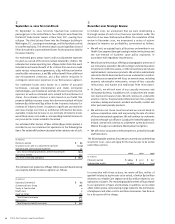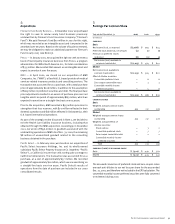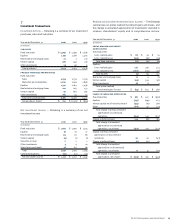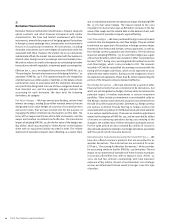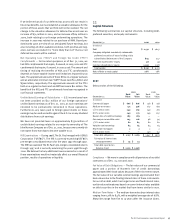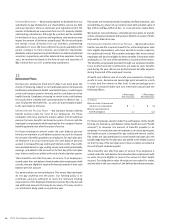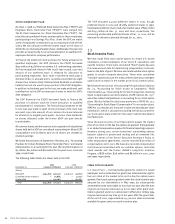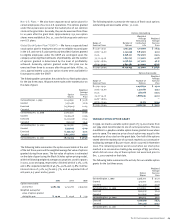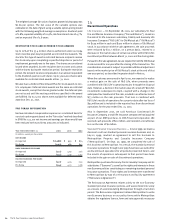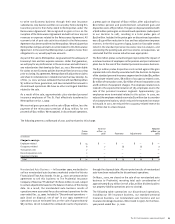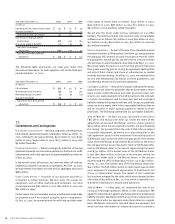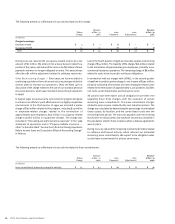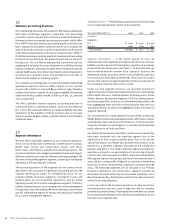Travelers 2001 Annual Report Download - page 62
Download and view the complete annual report
Please find page 62 of the 2001 Travelers annual report below. You can navigate through the pages in the report by either clicking on the pages listed below, or by using the keyword search tool below to find specific information within the annual report.
The St. Paul Companies 2001 Annual Report60
Dividend Restrictions — We primarily depend on dividends from our
subsidiaries to pay dividends to our shareholders, service our debt
and pay expenses. Various state laws and regulations limit the
amount of dividends we may receive from our U.S. property-liability
underwriting subsidiaries. Although $414 million will be available
for dividends in 2002, business and regulatory considerations may
impact the amount of dividends actually paid. We do not anticipate
the receipt of any dividends from our domestic underwriting
subsidiaries in 2002. We have sufficient resources available at the
parent company to fund common and preferred shareholder
dividends, interest payments and distributions on debt and preferred
securities, respectively, and other administrative expenses. During
2001, we received dividends in the form of cash and securities of
$827 million from our U.S. underwriting subsidiaries.
12
Retirement Plans
During 2000, employees hired prior to May 2000 were given the
choice of remaining subject to our traditional pension formula and
traditional postretirement health care benefits plan, or switching to
a new cash balance pension formula and/or cash balance retiree
health formula. Employees choosing to switch to the cash balance
formula(s) were credited with opening balances effective Jan. 1,
2001. Employees hired after Dec. 31, 2000 are automatically subject
to the cash balance formulas.
Defined Benefit Pension Plans — We maintain funded defined
benefit pension plans for most of our employees. For those
employees who have elected to remain subject to the traditional
pension formula, benefits are based on years of service and the
employee’s compensation while employed by the company. Pension
benefits generally vest after five years of service.
For those employees covered under the cash balance pension
formula, we maintain a cash balance pension account to measure
the amount of benefits payable to an employee. For each plan year
an employee is an active participant, the cash balance pension
account is increased for pay credits and interest credits. Pay credits
are calculated based on age, vesting service and actual pensionable
earnings, and added to the account on the first day of the next plan
year. Interest credits are added at the end of each calendar quarter.
These benefits vest after five years of service. If an employee is
vested under the cash balance formula when their employment with
us ends, they are eligible to receive the formula amount in their cash
balance pension account.
Our pension plans are noncontributory. This means that employees
do not pay anything into the plans. Our funding policy is to
contribute amounts sufficient to meet the minimum funding
requirements of the Employee Retirement Income Security Act and
any additional amounts that may be necessary. This may result in
no contribution being made in a particular year.
Plan assets are invested primarily in equities and fixed maturities, and
included 804,035 shares of our common stock with a market value of
$35 million and $44 million at Dec. 31, 2001 and 2000, respectively.
We maintain noncontributory, unfunded pension plans to provide
certain company employees with pension benefits in excess of limits
imposed by federal tax law.
Postretirement Benefits Other Than Pension — We provide certain
health care and life insurance benefits for retired employees (and
their eligible dependents), who have elected to remain subject to
the traditional formula. We currently anticipate that most covered
employees will become eligible for these benefits if they retire while
working for us. The cost of these benefits is shared with the retiree.
The benefits are generally provided through our employee benefits
trust, to which periodic contributions are made to cover benefits
paid during the year. We accrue postretirement benefits expense
during the period of the employee’s service.
A health care inflation rate of 10.00% was assumed to change to
9.00% in 2002; decrease one percentage point annually to 5.00%
in 2006; and then remain at that level. A one-percentage-point
change in assumed health care cost trend rates would have the
following effects.
1-Percentage- 1-Percentage-
Point Increase Point Decrease
(In millions)
Effect on total of service and
interest cost components $ 2 $ (2)
Effect on postretirement
benefit obligation 27 (22)
For those employees covered under the cash balance retiree health
formula, we maintain a cash balance retiree health account (“health
account”) to measure the amount of benefits payable to an
employee. For each plan year an employee is an active participant,
the health account is increased for pay credits and interest credits.
Pay credits are calculated based on pensionable earnings up to the
taxable wage base for the plan year and added to the health account
on the first day of the next plan year. Interest credits are added at
the end of each calendar quarter.
These benefits vest after five years of service. If an employee is
vested under the cash balance formula when their employment with
us ends, they are eligible to receive the amount in their health
account. Our obligations under this plan are accounted for under,
and included in the 2001 results of, the defined benefit pension plan.


